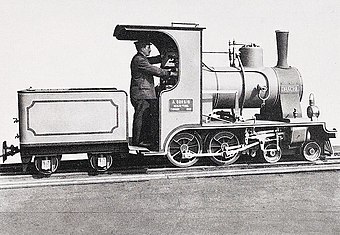Round track in the Hagenbeck Zoo
| Round track in the Hagenbeck Zoo | |||||||||||||||||
|---|---|---|---|---|---|---|---|---|---|---|---|---|---|---|---|---|---|
|
Round track with 600 mm gauge in Hagenbeck's
zoo with 2B construction locomotive Drache 2B construction locomotive Drache , built in 1909 by the Berlin locomotive factory A. Borsig  | |||||||||||||||||
| Gauge : | 600 mm ( narrow gauge ) | ||||||||||||||||
|
|||||||||||||||||
The circular track in the Hagenbeck Zoo was a ring-shaped, narrow-gauge railway with a gauge of 600 millimeters. In the four and a half years of its existence it carried approximately 610,000 visitors to the zoo in Hamburg .
history
On May 7, 1907, Carl Hagenbeck opened the world's first zoo without bars at its current location in the Hamburg district of Stellingen ; Around two years later, the park railway was put into operation as an additional attraction for adults and children. In addition to entertainment, it was also used for technical youth education. The regular journeys ended after around four and a half years in autumn 1913. The First World War , especially the post-war period, led to the decline of the railroad because, as Carl Hagenbeck announced in a letter dated September 17, 1926, “the most valuable parts of the machine were stolen during the war ”.
Before the Second World War , in 1938 there was hope of being able to put a miniature railway back into operation on the route in the zoo .
A source from 1938 mentions the circular railway from 1909 to 1913 as one of the first German Liliput railways in the sense of the time, or a stage of development there, whereby the larger track width of 600 millimeters and the engine driver standing in the driver's cab make a distinction possible. Furthermore, according to this source, the park railway was the first German show railway that "directed the interest of young people to the railway system and the locomotive".
business
The park railway was only operated in the summer months from April / May to September / October. The journey led, among other things, past a small pond as well as a stone dinosaur several meters high and an eagle's nest; sometimes the railway is described as "idyllically located".
The number of passengers was as follows:
| year | Operating time | Passengers |
|---|---|---|
| 1909 | May 15–24. October | 152.413 |
| 1910 | April 1–15. October | 144,642 |
| 1911 | April 15–15. October | 107.259 |
| 1912 | April 15–30. September | 92,789 |
| 1913 | May 1–30. September | 114,363 |
Rail vehicles
dare
The train consisted of 8 two-axle covered passenger cars (wheel diameter 300 mm) with 8 pairs of seats each and carried a total of 64 people.
locomotive
The main dimensions of the 2B construction locomotive Drache with a two-axle tender , built in 1909 by the A. Borsig locomotive factory , Berlin-Tegel , were as follows:
Hagenbeck's dragon
- Type : 2B
- Track width: 600 mm
- Total length over the buffers: 4760 mm
- Length of the machine: 3170 mm
- Length of the tender: 1590 mm
- Width over the running plates: 1300 mm
- Height to the top of the chimney: 2000 mm
- Cylinder bore: 115 mm
- Piston stroke: 200 mm
- Operating pressure: 15 at
- Power: 10 hp
- Heating area: 4 m²
- Grate area 0.16 m²
- Driving and coupling wheels: 550 mm
- Front bogie wheels: 300 mm
- Tender wheels (4): 300 mm
- Empty weight of the machine: 3.2 t
- Operating weight of the machine: 3.5 t
- Empty weight of the tender: 0.75 t
- Operating weight of the tender: 1.65 t
- Overall axle base of the machine: 1400 mm
- Fixed wheel base of the machine: 600 mm
- Axle base of the tender: 700 mm
- Water supply in the tender: 50 l
- The tender's coal supply: 0.3 m³
The name Dragon is insofar surprising as a disguised as street Dragon locomotive 1888 elephants disaster of Munich had triggered.
Individual evidence
- ↑ a b c d Walter Strauss: Liliputbahnen: an overview of miniature trains transporting people with an appendix on manned ship models. Darmstadt, 1938. pp. 10-12.
Coordinates: 53 ° 35 ′ 47 " N , 9 ° 56 ′ 16" E
